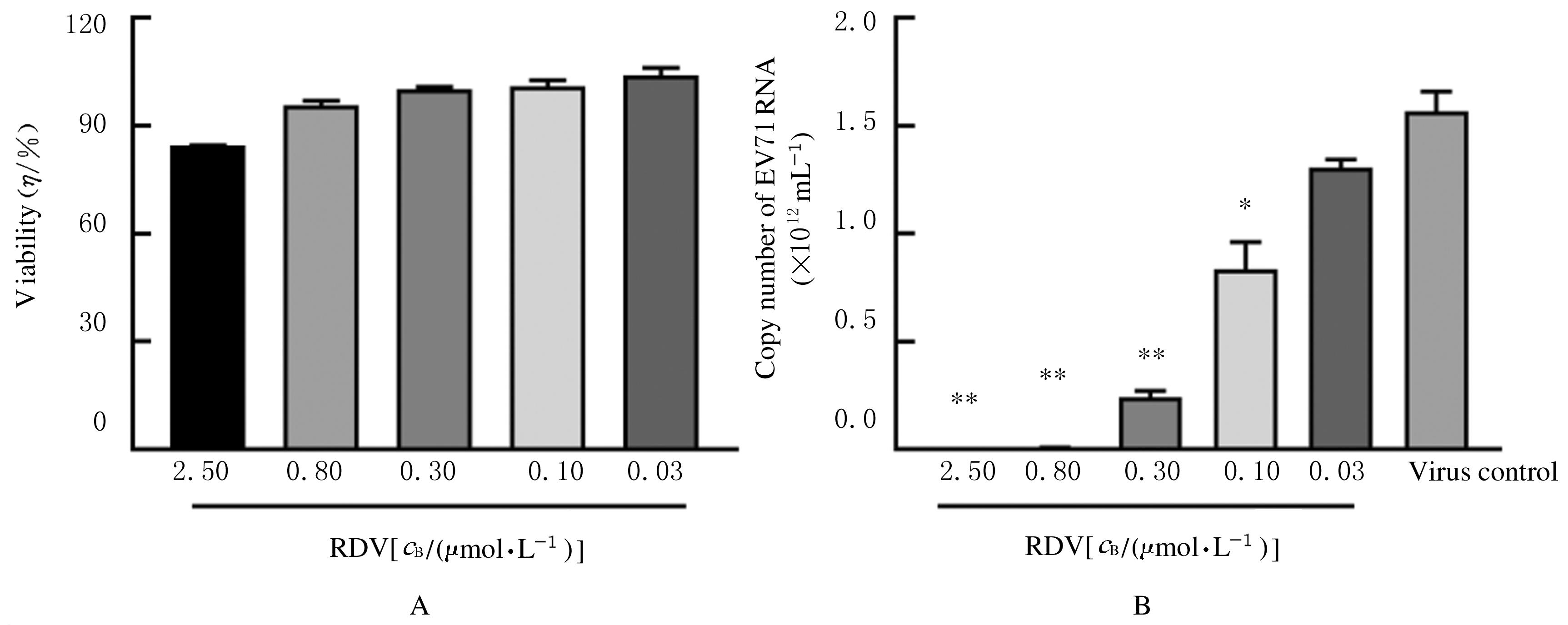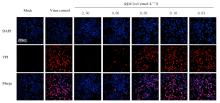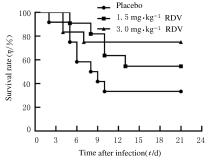吉林大学学报(医学版) ›› 2021, Vol. 47 ›› Issue (6): 1446-1454.doi: 10.13481/j.1671-587X.20210614
瑞德西韦对感染肠道病毒71型的人横纹肌瘤细胞和 ICR乳鼠的抗病毒活性
任晓风1,闫赟政2,李微2,李月香2,肖军海2,曹瑞源2( ),李永刚1(
),李永刚1( )
)
- 1.锦州医科大学基础医学院病原生物学教研室,辽宁 锦州 121000
2.军事科学院军事医学研究院毒物药物研究所,北京 100850
Antiviral activity of remdesivir against human rhabdomyosarcoma cells and ICR suckling mice infected with enterovirus 71
Xiaofeng REN1,Yunzheng YAN2,Wei LI2,Yuexiang LI2,Junhai XIAO2,Ruiyuan CAO2( ),Yonggang LI1(
),Yonggang LI1( )
)
- 1.Department of Pathogenic Biology,School of Basic Medical Sciences,Jinzhou Medical University,Jinzhou 121000,China
2.Institute of Pharmacology and Toxicology,Academy of Military Medical Sciences,Academy of Military Sciences,Beijing 100850,China
摘要: 探讨瑞德西韦(RDV)在细胞与动物水平对肠道病毒71型(EV71)的抗病毒活性,并阐明其抗病毒作用机制。 基于人横纹肌瘤(RD)细胞进行RDV抗肠道病毒活性评价,检测RDV对EV71、柯萨奇病毒A6型(CA6)、肠道病毒D68型(EVD68)和柯萨奇病毒16型(CA16)的半数毒性浓度(CC50)和半数有效浓度(EC50),计算选择指数(SI)。将RD细胞分为细胞对照组(不处理)、病毒对照组和给药组。病毒对照组RD细胞给予EV71病毒液,给药组RD细胞再给予不同浓度(0.005、0.015、0.046、0.137、0.410、1.230、3.700、11.110、33.330和100.000 μmol·L-1)RDV。72 h后,采用CellTiter-Glo? Luminescent检测试剂盒测定各组RD细胞活性。在抗EV71细胞活性评价实验中,将RD细胞分为给药组和病毒对照组,给药组RD细胞给予不同浓度(0.03、0.10、0.30、0.80和2.50 μmol·L-1)RDV。30 h后,采用实时荧光定量PCR(RT-qPCR)法检测各组RD细胞中EV71 RNA表达水平,采用Western blotting法和免疫荧光法检测各组RD细胞中EV71结构蛋白VP1表达量。采用加药时序实验验证RDV的抗病毒作用阶段。在抗EV71动物药效学实验中,将35只ICR乳鼠随机分为安慰剂组(给予2% Tween 80,n=12)、3.0 mg·kg-1RDV组(给予3.0 mg·kg-1 RDV,n=12)和1.5 mg·kg-1组RDV组(给予1.5 mg·kg-1 RDV, n=11),每只乳鼠经腹腔攻毒5×103 PFU。4 h后进行第1次给药,连续给药2周,观察并记录乳鼠生存率。在攻毒后第3 天采用RT-qPCR法检测各组乳鼠各种组织中病毒载量(即EV71 RNA拷贝数)。 RDV对EV71、CA6、EVD68和CA16的EC50分别为(0.05±0.01)、(0.14±0.06)、(0.02±0.01)和(0.10±0.03) μmol·L-1。与病毒对照组比较,0.10、0.30、0.80和2.50 μmol·L-1RDV组RD细胞中EV71 RNA表达水平降低(P<0.05或P<0.01),0.80和2.50 μmol·L-1RDV组RD细胞中EV71结构蛋白VP1表达量降低。与病毒对照组比较,0.80 μmol·L-1RDV组RD细胞中Ⅲ和Ⅳ阶段(病毒复制阶段)时EV71病毒基因组RNA拷贝数明显降低(P<0.05)。与安慰剂组比较,各给药组乳鼠生存率差异无统计学意义(P>0.05),但有一定的保护趋势。与安慰剂组比较,3.0 mg·kg-1RDV组乳鼠肺和肌肉组织中病毒载量明显降低(P<0.05或P<0.01)。 RDV对以EV71为代表的肠道病毒具有良好的细胞水平抗病毒活性,并主要作用于病毒感染后的复制阶段。RDV能明显降低小鼠肺和肌肉组织中病毒载量,提示其在动物水平有一定的治疗潜力。
中图分类号:
- R512.5














